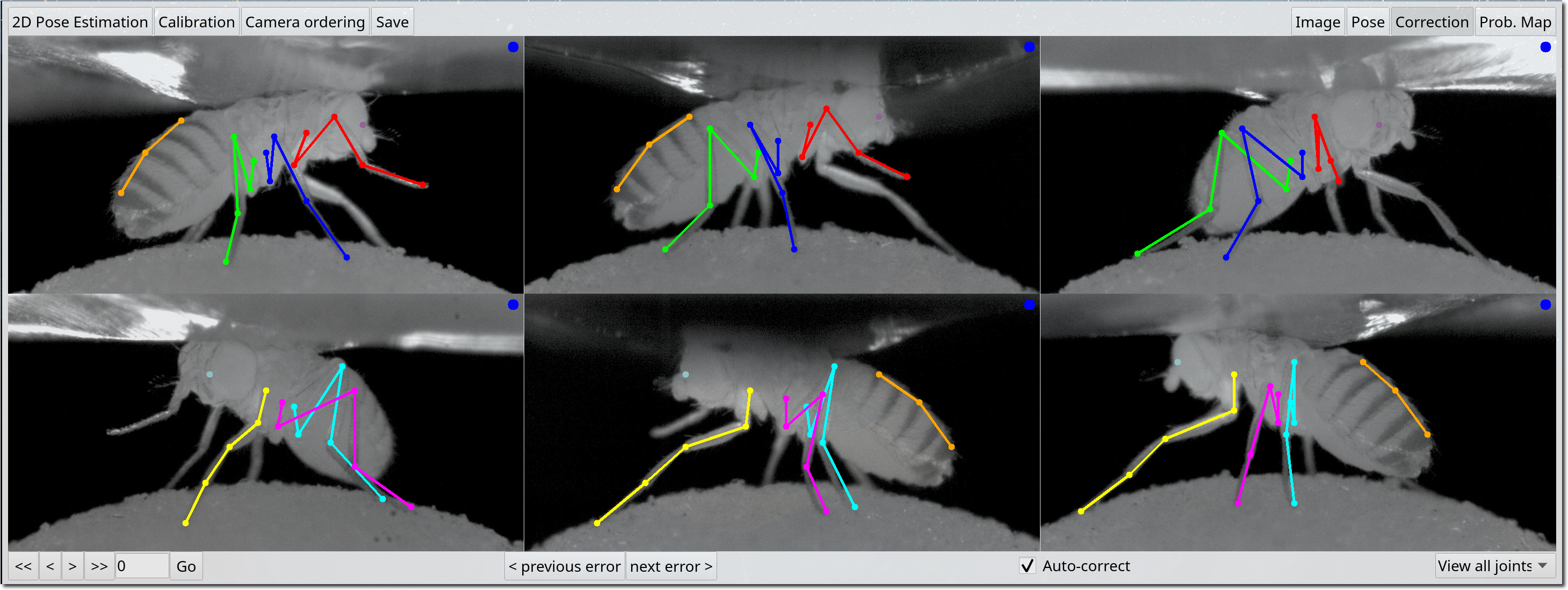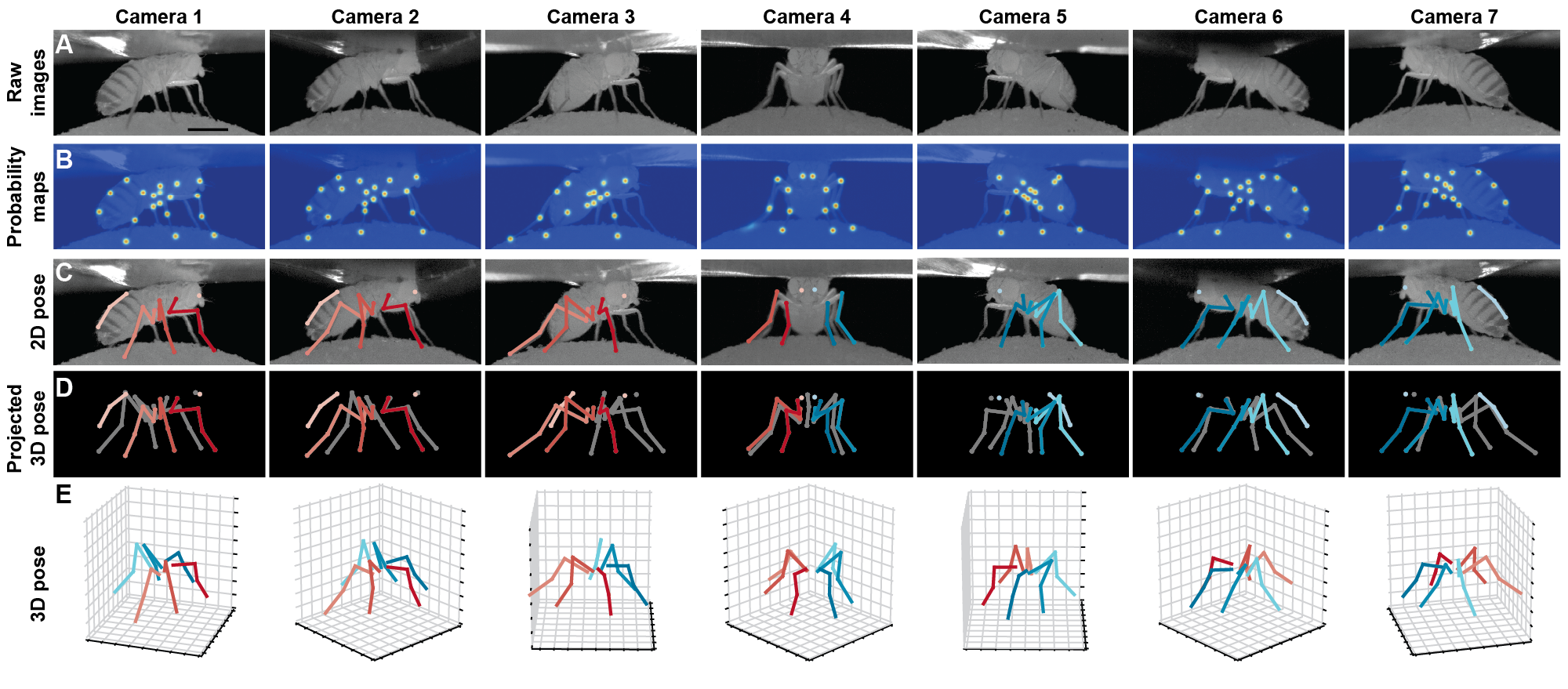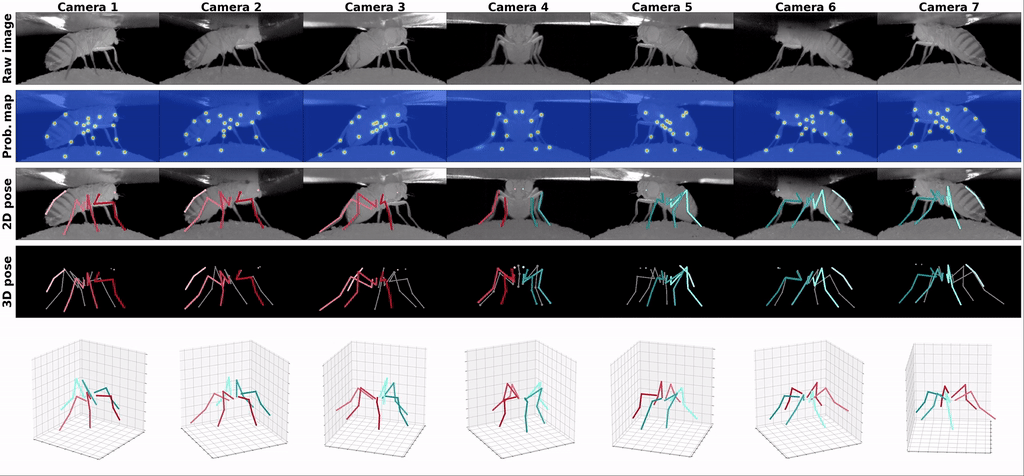NeLy-EPFL / Deepfly3d
Labels
Projects that are alternatives of or similar to Deepfly3d
DeepFly3D
DeepFly3D is a PyTorch and PyQT5 implementation of 2D-3D tethered Drosophila pose estimation. It aims to provide an interface for pose estimation and to permit further correction of 2D pose estimates, which are automatically converted to 3D pose.
DeepFly3D does not require a calibration pattern, it enforces geometric constraints using pictorial structures, which corrects most of the erros, and the remaining errors are automatically detected can be dealt easily with GUI assistance.
Code for data preparation and augmentation are taken from the Stacked hourglass network. We also use the Stacked Hourglass model for 2D pose estimation. We implement custom advances (e.g., GUI) using PyQT5.
- Installing DeepFly3D: Installation
- Interacting with the GUI: GUI
- If you want to train 2D estimator instead: 2D Pose
- Generating visualizations: Visualization
- If you are interested in the online annotation tool instead: DeepFly3DAnnotation
- To see the whole dataset used in the paper: Dataverse
- Adapting DeepFly3D on different datasets: Adapting (Will be updated soon)
Changes
Changes in 0.4
- Using the CLI, the output folder can be changed using the
--output-folderflag - CLI and GUI now use the same pose estimation code, so changes will automatically propagate to both
- Minor tweaks in the GUI layout, functionality kept unchanged
Changes in 0.3
- Results are saved in df3d folder instead of the image folder.
- Much faster startup time.
- Cameras are automatically ordered using Regular Expressions.
- CLI improvements. Now it includes 3D pose.
Changes in 0.2
- Changing name from deepfly3d to df3d
- Adding cli interface with df3d-cli
- Removing specific dependencies for numpy and scipy
- Removing L/R buttons, so you can see all the data at once
- Removing the front camera
- Faster startup time, less time spent on searching for the image folder
- Better notebooks for plotting
- Adding procrustes support. Now all the output is registere to template skeleton.
- Bug fixes in CameraNetwork. Now calibration with arbitrary camera sequence is possible.
Known Problems
- Some insability in automatic correction
GUI
 DeepFly3D provides a nice GUI to interact with the data. Using DeepFly3D GUI, you can visualize:
DeepFly3D provides a nice GUI to interact with the data. Using DeepFly3D GUI, you can visualize:
- Raw data
- Probability maps
- Raw predictions
- Automatic corrections
And you can perform:
- 2D pose estimation
- Calibration without calibration pattern
- Saving the final 3D estimations
- Manual Correction
Identifying erroneous estimates automatically
 DeepFly3D can automatically detect when 2D pose estimation is failed.
DeepFly3D can automatically detect when 2D pose estimation is failed.
Auto-correction
 DeepFly3D will try to fix these mistaked using multi-view geometry and pictorial structures. In the next iteration of training, you can also use these examples to train the 2D estimation network! Auto-correction is perfomed if 2D pose estimation and calibration are complete.
DeepFly3D will try to fix these mistaked using multi-view geometry and pictorial structures. In the next iteration of training, you can also use these examples to train the 2D estimation network! Auto-correction is perfomed if 2D pose estimation and calibration are complete.
Assisting manual correction
In the 'Correction' mode, the GUI tries to correct errors using pictorial structures. To save these corrections, press T. Please check the associated manuscript (Günel et al. 2019) for implementation details.
 In the next iteration of training, you can use these examples to train the network!
In the next iteration of training, you can use these examples to train the network!
Visualization
And nice visualizations! Check the Visualization doc for details. In general, displaying pose estimation results should be as easy as:
import matplotlib.pyplot as plt
from deepfly.CameraNetwork import CameraNetwork
camNet = CameraNetwork(image_folder=image_folder)
image_folder = './data/test'
plt.imshow(camNet.cam_list[1].plot_2d())
and to display heatmaps:
plt.imshow(camNet.cam_list[1].plot_heatmap())
To create more complicated figures, or replicate the figures from the paper, you can use the the pose_result file which is saved in the same folder as the images. The notebook, notebook_visualize/visualize.ipynb, shows you the steps to create the following figure:

To visualize the time series instead, use the notebook notebook_visualize/time_series.ipynb. It should output 2D/3D pose, along with a few selected time series.
Using different datasets
It is possible to use DeepFly3D on other animals! Check the Adaptation text to see an example of H3.6m multi-view human dataset.
References
@inproceedings{Gunel19DeepFly3D,
author = {Semih Gunel and
Helge Rhodin and
Daniel Morales and
João Compagnolo and
Pavan Ramdya and
Pascal Fua},
title = {DeepFly3D, a deep learning-based approach for 3D limb and appendage tracking in tethered, adult Drosophila},
bookTitle = {eLife},
doi = {10.7554/eLife.48571},
year = {2019}
}
@inproceedings{Newell16Stacked,
author = {Alejandro Newell and
Kaiyu Yang and
Jia Deng},
title = {Stacked Hourglass Networks for Human Pose Estimation},
booktitle = {Computer Vision - {ECCV} 2016 - 14th European Conference, Amsterdam,
The Netherlands, October 11-14, 2016, Proceedings, Part {VIII}},
pages = {483--499},
year = {2016},
doi = {10.1007/978-3-319-46484-8\_29},
}
We want to thank to Florian Aymanns for testing of the software and for his helpful comments.




